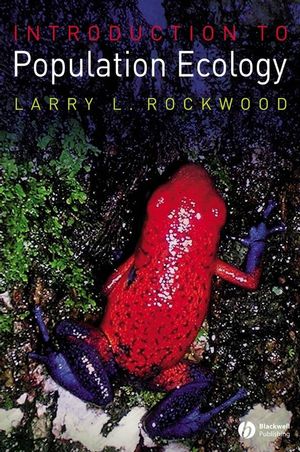Introduction to Population EcologyISBN: 978-1-4051-3263-3
Paperback
352 pages
February 2006, Wiley-Blackwell
 This title is out-of-print and not currently available for purchase from this site.
|
Mathematical Symbols Used.
Part I: Single Species Populations.
1. Density Independent Growth.
Introduction.
Fundamentals of Population Growth.
Types of Models.
Density Independent vs. Density Dependent Growth.
Discrete or “Geometric” Growth in Populations with Non-overlapping Generations.
Exponential Growth in Populations with Overlapping Generations.
Exponential Growth in an Invasive Species.
Applications to Human Populations.
The Finite Rate of Increase and the Intrinsic Rate of Increase.
Stochastic Models of Population Growth and Population Viability Analysis.
Summary.
2. Density Dependent Growth and Intraspecific Competition.
Introduction.
Density Dependence in Populations with Discrete Generations.
Density Dependence in Populations with Overlapping Generations.
Nonlinear Density Dependence of Birth and Death Rates and the Allee Effect.
Time Lags and Limit Cycles.
Chaos and Behavior of the Discrete Logistic Model.
Adding Stochasticity to Density Dependent Models.
Laboratory and Field Data.
Behavioral Aspects of Intraspecific Competition.
Summary.
3. Population Regulation.
Introduction.
What is Population Regulation?.
Combining Density Dependent and Density Independent Factors.
Tests of Density Dependence.
Summary.
4. Populations with Age Structures.
Introduction.
Survivorship.
Fertility.
Mortality Curves.
Expectation of Life.
Net Reproductive Rate, Generation Time and the Intrinsic Rate of Increase.
Age Structure and the Stable Age Distribution.
Projecting Population Growth in Age Structured Populations.
The Leslie or Population Projection Matrix.
A Second Version of the Leslie Matrix.
The Lefkovitch Modification of the Leslie Matrix.
Dominant Latent Roots and the Characteristic Equation.
Reproductive Value.
Summary.
5. Metapopulation Ecology.
Introduction.
Metapopulations and Spatial Ecology.
MacArthur and Wilson and the Equilibrium Theory.
The Levins or Classical Metapopulation.
Extinction in Metapopulations.
Metapopulation Dynamics of Two Local Populations.
Source-Sink Metapopulations and the Rescue Effect.
Non-equilibrium and Patchy Metapopulations.
Spatially Realistic Models.
Minimum Viable Metapopulation Size.
Assumptions and Evidence for the Existence of Metapopulations in Nature.
Summary.
6. Life History Strategies.
Introduction.
Power Laws.
The Metabolic Theory of Ecology.
Cole and Lewontin.
The theory of r- and K-selection.
Cost of Reproduction and Allocation of Energy.
Clutch Size.
Latitudinal gradients in Clutch Size.
Predation and its Effects on Life History Characteristics.
Bet Hedging.
The Grime General Model for Three Evolutionary Strategies in Plants.
Summary.
Part II: Interspecific Interactions.
7. Interspecific Competition.
Introduction.
Interspecific Competition: Early Experiments and the Competitive Exclusion Principle.
The Lotka-Volterra Competition Equations.
Laboratory Experiments and Competition.
Resource Based Competition Theory.
Spatial Competition and the Competition-Colonization Trade-off.
Evidence for Competition From Nature.
Indirect Evidence for Competition and "Natural Experiments".
Summary.
8. Mutualism.
Introduction.
Modeling Mutualism.
Summary.
9. Host-Parasite Interactions.
Introduction.
Factors Affecting Microparasite Population Biology.
Modeling Host-Microparasite Interactions.
Dynamics of the Disease.
Immunization.
Endangered Metapopulations and Disease.
Social Parasites.
Summary.
10. Predator/Prey Interactions.
Introduction.
The Lotka Volterra Equations.
Early Tests of the Lotka-Volterra Models.
Functional Responses.
Adding Prey Density Dependence and the Type II and III Functional.
Responses to the Lotka Volterra Equations.
The Graphical Analyses of Rosenzweig and MacArthur.
Use of a Half Saturation Constant in Predator/Prey Interactions.
Parasitoid/Host Interactions and the Nicholson-Bailey Models.
Section Summary.
Field Studies.
Trophic Cascades.
The Dangers of a Predatory Lifestyle.
Escape from Predation.
Summary.
11. Plant-Herbivore Interactions.
Introduction.
Classes of Chemical Defenses.
Constitutive vs. Induced Defense.
Plant Communication.
Plant-Parasitoid Communication.
A Classic Set of Data Reconsidered.
Novel Defenses/Herbivore Responses.
Detoxification of Plant Compounds by Herbivores.
Plant Apparency and Chemical Defense.
Soil Fertility and Chemical Defense.
The Optimal Defense Theory.
Modeling Plant-Herbivore Population Dynamics.
Summary.
References.
Appendix 1: Exercises.
Appendix 2: Matrix Algebra: the Basics.
Index



